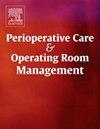The incidence of postoperative atelectasis following gastrointestinal procedures in pediatric population
IF 1
Q2 Nursing
Perioperative Care and Operating Room Management
Pub Date : 2025-06-18
DOI:10.1016/j.pcorm.2025.100510
引用次数: 0
Abstract
Background
Postoperative pulmonary complications including atelectasis are common complications after surgery. However, the incidence of postoperative atelectasis in pediatric surgical population is not yet well delineated.
Methods
Using electronic medical record, we identified pediatric patients who underwent gastrointestinal surgery from January 2016 to September 2019 and determined the presence or absence of postoperative atelectasis by postoperative X-ray read. Risk factor analysis of postoperative atelectasis was performed using logistic regression analysis.
Results
We found that 25.6 % of patients had radiographic evidence of postoperative atelectasis. Univariate and multivariate analyses demonstrated that the risk factors included lower weight, higher ASA class, emergency surgery, the use of higher peak airway pressure, lower lung compliance, and the lack of neuromuscular relaxant reversal agent use. In patients who received muscle relaxants, the lack of neuromuscular relaxant reversal agent use was associated with an increased risk of postoperative atelectasis (odds ratio 0.421, 95 % confidence interval 0.235–0.723, p < 0.001).
Discussion
Postoperative atelectasis was frequently observed in pediatric patients undergoing gastrointestinal surgery. For cases where neuromuscular blockade is used, adequate reversal is critical.
小儿胃肠手术后肺不张的发生率
背景术后肺并发症包括肺不张是手术后常见的并发症。然而,小儿手术人群术后肺不张的发生率尚未得到很好的描述。方法使用电子病历,对2016年1月至2019年9月接受胃肠手术的儿童患者进行分析,并通过术后x线阅读确定是否存在术后肺不张。采用logistic回归分析术后肺不张的危险因素。结果25.6%的患者有术后肺不张的影像学证据。单因素和多因素分析表明,危险因素包括体重较轻、ASA等级较高、急诊手术、使用较高的气道峰值压力、较低的肺顺应性以及缺乏使用神经肌肉松弛剂逆转剂。在接受肌肉松弛剂治疗的患者中,缺乏神经肌肉松弛剂逆转剂的使用与术后肺不张的风险增加相关(优势比0.421,95%可信区间0.235-0.723,p <;0.001)。讨论小儿胃肠手术患者术后常出现肺不张。对于使用神经肌肉阻断的病例,充分的逆转是至关重要的。
本文章由计算机程序翻译,如有差异,请以英文原文为准。
求助全文
约1分钟内获得全文
求助全文
来源期刊

Perioperative Care and Operating Room Management
Nursing-Medical and Surgical Nursing
CiteScore
1.30
自引率
0.00%
发文量
52
审稿时长
56 days
期刊介绍:
The objective of this new online journal is to serve as a multidisciplinary, peer-reviewed source of information related to the administrative, economic, operational, safety, and quality aspects of the ambulatory and in-patient operating room and interventional procedural processes. The journal will provide high-quality information and research findings on operational and system-based approaches to ensure safe, coordinated, and high-value periprocedural care. With the current focus on value in health care it is essential that there is a venue for researchers to publish articles on quality improvement process initiatives, process flow modeling, information management, efficient design, cost improvement, use of novel technologies, and management.
 求助内容:
求助内容: 应助结果提醒方式:
应助结果提醒方式:


